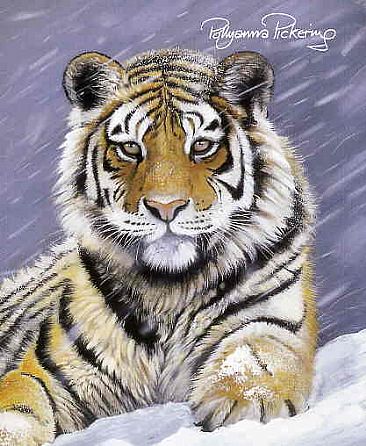 |

        
 

Members
Login

| On March 28, 2007, UK artist Pollyanna Pickering and her daughter/manager Anna-Louise Pickering departed for Bhutan sketch and paint the rare flora and fauna of this largely undisturbed region of the Himalayas.
Find out more... |
|
|

|
|
| |

| Land of the Snow Tiger Exhibition |
 |

Pollyanna's 2005 Summer Exhibition was once again a great success. Visitors to the gallery were able to view over fifty paintings inspired by her toughest challenge yet - an expedition to the wastelands of Siberia to sketch the critically endangered Amur Tigers, and the snowbound wilderness in which they live. Also on display was the award winning 'Study of Wolves' painting, honoured with a Gold Medal by The Wildlife Art Society International, and a fascinating selection of artefacts brought back from Siberia.
Pollyanna braved temperatures as low as -60 to work alongside scientists from the Wildlife Conservation Society's Siberian Tiger Project, joining them in radio tracking these elusive animals in the snowbound Sikhote Alin Mountains of Russia's inaccessible far east. This beautiful species - the world's largest tiger - has been brought back from the very brink of extinction. In the 1940's only 30 wild tigers remained After a gruelling four day journey to reach the remote reserve, Pollyanna lived in a tiny log cabin in the forests, without running water or electricity and had to walk out across the surface of a frozen river each evening to fill buckets of water through a hole in the ice to take back to the cabin. All the hardships were worth it to get a sighting of a wild tiger. Pollyanna was also able to sketch a family of tiger cubs at a wildlife research station near Spassk.
Ten percent of all sales at the exhibition are being donated through The Pollyanna Pickering Foundation to help tiger conservation.
A crisis is still looming in the Russian Far East, very close to the area visited by Pollyanna earlier this year. Plans to build the world's longest oil pipeline threaten the rarest cat on earth - the pipeline would run through a UNESCO Biosphere Reserve ' Kedrovaya Pad' which is home to a quarter of Russia's threatened species, including Siberian Tigers, and the Amur Leopard, of which only 30 remain in the wild. Ecologists have said that it would be impossible to select a site which would do more damage to the environment in terms of habitat damage and pollution. We implore you to write to :
His Excellency Mr Grigory B. Karasin, Ambassador of the Russian Federation, Embassy of the Russian Federation, 13 Kensington palace Gardens, London W8 4QX and
UNESCO Moscow Office, Bolshoi Levshinky per., 15/28, Bld 2, 119034 Moscow, Russia.
|
|
|
|
| |
 |
|
|
 |
 |
|

|
|